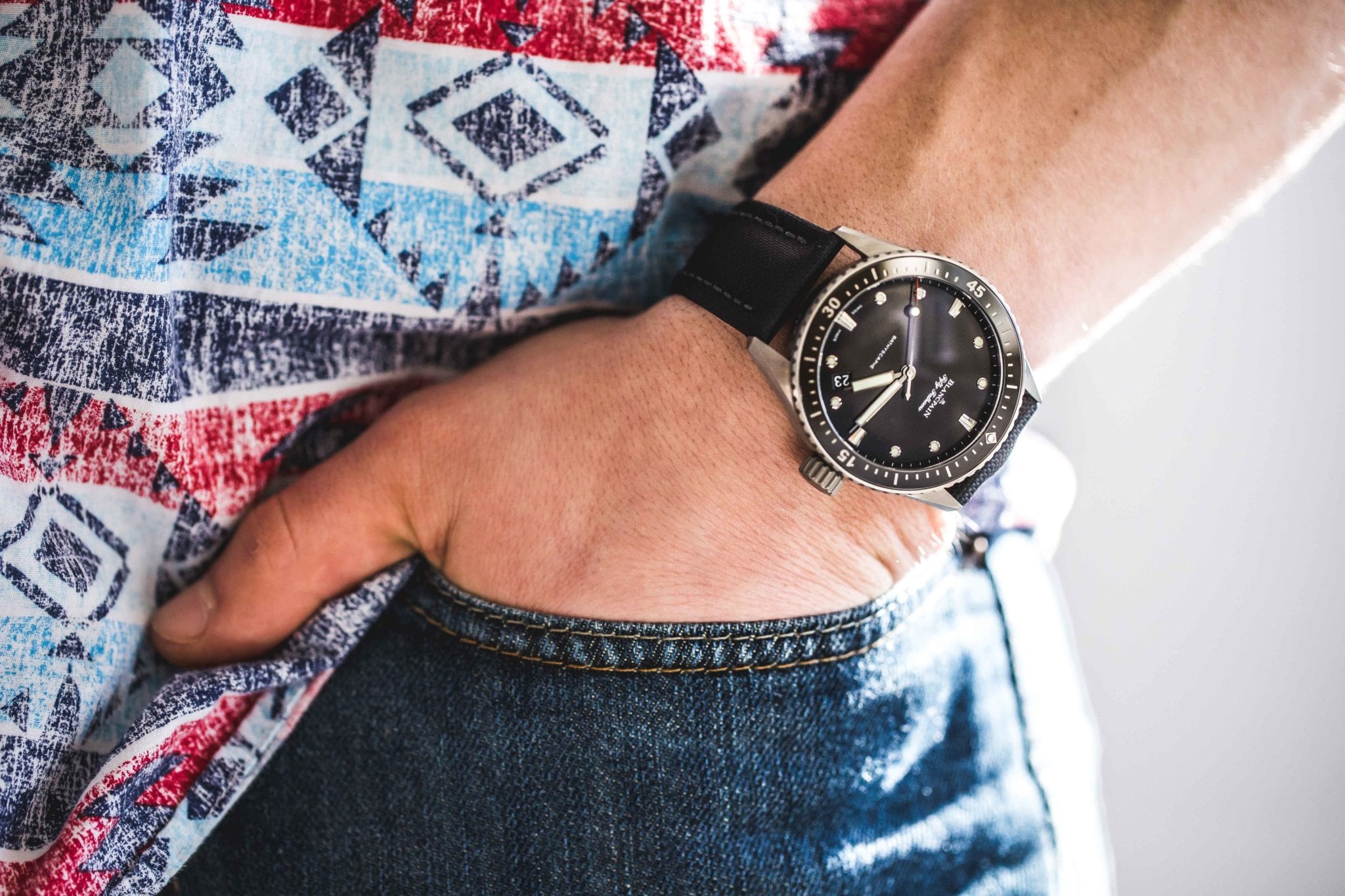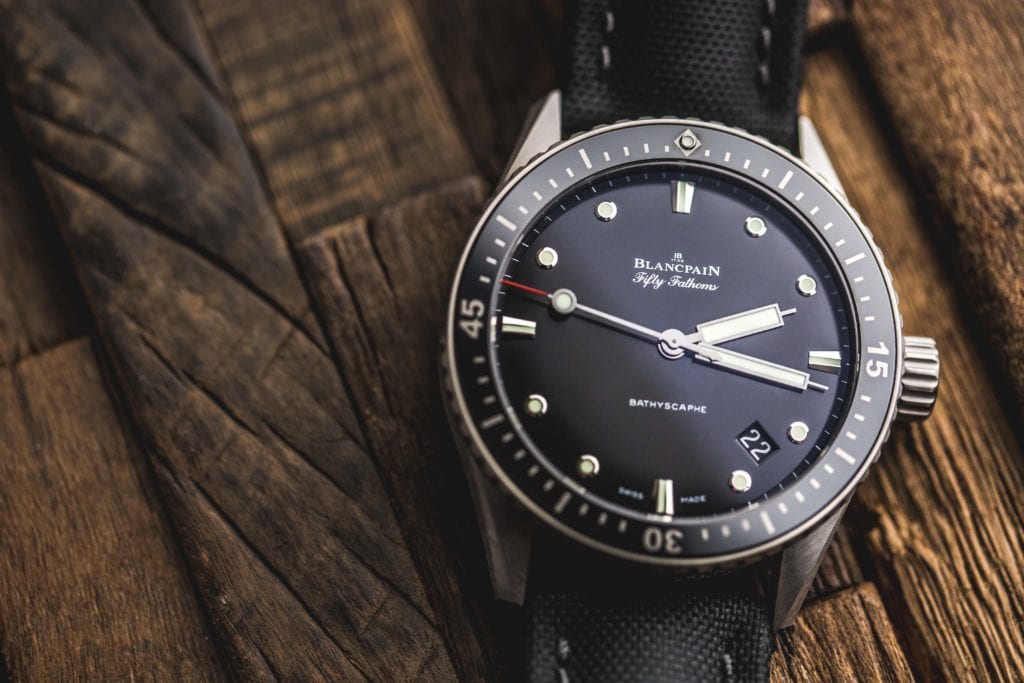

When you consider the quintessential dive watch, a number of different models probably come to mind. You may think of the Rolex Submariner, the OMEGA Seamaster, or the Breitling Superocean. Still, the original dive watch optimized for professional divers was the Blancpain Fifty Fathoms. In 1950, the new CEO of Blancpain and avid diver Jean-Jacques Fiechter aimed to create the ultimate dive watch.
His impetus was a near-fatal diving experience he had off the coast of France. During a dive, Fiechter lost track of time and ran out of air. This made him realize that a reliable timekeeping device was just as vital to a diver as an oxygen tank. In three short years, Fiechter made his dream a reality with the Fifty Fathoms in 1953. However, he didn’t do it alone. He enlisted the help of some of the most elite divers in the world: navy frogmen. Together, they developed one of the most robust dive watches on the market. This is the story of the Blancpain Fifty Fathoms.


Around the same time Fiechter came to Blancpain as CEO, the French Ministry of Defense established a new unit of commando frogmen, similar to the United States’ Navy Seals. Captain Robert Maloubier and Lieutenant Claude Jean Riffaud headed up the group. Soon, they began looking for a mechanical watch fit for their squadron. Unknowingly, Fiechter, Maloubier, and Riffaud were in search of a similar model. It needed to be water resistant, antimagnetic, self-winding, and highly legible in any conditions, from murky waters to nighttime.
Fiechter quickly began research and development. Soon, he’d patented a doubled sealed crown that ensured the watch’s water resistance even if got pulled out. He also patented a unique, notched, unidirectional rotating bezel that could help divers to track elapsed time during a dive. In addition, he patented a locking mechanism for the bezel. This not only kept the bezel from rotating and giving inaccurate elapsed time but also kept out salt and sand. Lastly, Fiechter patented a new screw-down caseback technology by enhancing the seal.
It wasn’t long before Maloubier and Riffaud heard of Fiechter’s patents and development of a new dive watch. They approached him and quickly realized they all shared the same vision for a model unlike any other made before. Maloubier and Riffaud brought their ideas to the table. The watch should feature a black dial and large, bold, luminescent markers. A short time later, Feichter delivered twenty prototypes to Maloubier and Riffaud for testing. The watches passed with flying colors. Then, in 1953, the Blancpain Fifty Fathoms became the official watch of the French combat diving corps.
A year later in 1954, Blancpain debuted the model to the world at the annual Baselworld fair. It came equipped with all the technical features patented by Fiechter and the design specifications set by Maloubier and Riffaud. In addition, it featured a 42mm case, which was quite large for the era. The Fifty Fathoms also boasted a depth rating of, you guessed it, 50 fathoms or roughly 91 meters.
The Fifty Fathoms quickly caught the attention of other divers and military forces. Soon, Israel, America, Spain, Germany, and others began issuing the model. After a few more years, the Fifty Fathoms received attention within the civilian market. In 1956, famed diver Jacques-Yves Cousteau wore the model in an underwater documentary called The Silent World. The film went on to win the Palme d’Or at the Cannes Film festival and an Oscar the following year. Despite its more widespread presence, the Fifty Fathoms continued to be considered a divers tool more than a typical wristwatch. As a result, you’d most often find the model at diving shops instead of traditional jewelers or watch boutiques.
Over the years, the design of the Fifty Fathoms continued to evolve. One of the most important updates to the collection came in the 1960s with the release of radiation safe models. You may be familiar with Panerai’s shift from the Radiomir that used a radium-based material for its lume to the Luminor that used a safer luminescent material. Blancpain went through a similar shift with the Fifty Fathoms. Into the 1970s, Blancpain went on to create dozens of different models for certain military forces and their specifications. Some of the most notable reflect a trend of the era: the cushion-shaped case.
By 1980, the Quartz Crisis had made such an impact on Blancpain, the company was forced to close its doors. It was then that the future of the Fifty Fathoms became uncertain. Three years later, the legendary Jean-Claude Biver purchased the brand and revived it. However, Biver’s intention was to take the brand back to its roots, with models that proceeded the Fifty Fathoms. It wasn’t until after the illustrious Swatch Group purchased Blancpain in 1993 that the Fifty Fathoms would finally re-enter the brand’s catalog.
After a nearly two decade hiatus, the model made its monumental return in 1997. It did so as part of a trilogy of the brand’s timepieces for land, air, and sea. Still, it wouldn’t be until another decade later in 2007 that the Fifty Fathoms was officially reborn as a collection. The 2007 edition and the models to follow closely capture the spirit of vintage Fifty Fathom designs. However, they boast modern upgrades, like greater water resistance up to 300 meters and manufacture movements.
Protect What You Love With Hodinkee Insurance We're here to help avoid a potential heartache.…
Watching Movies: Adam Driver Takes Over The Gucci Family Empire Wearing A JLC Reverso in…
Second Opinions: The Tudor Black Bay Fifty-Eight Is Not A Submariner Alternative It's its own…
Your Watch Just Tripled In Value – Now What? Auction season is around the corner.…
A Week On The Wrist: The 40mm TAG Heuer Aquaracer Could Be Your Only Watch…
Five Critical Things To Do Before Buying A Watch Online Originally published by Hodinkee, March…